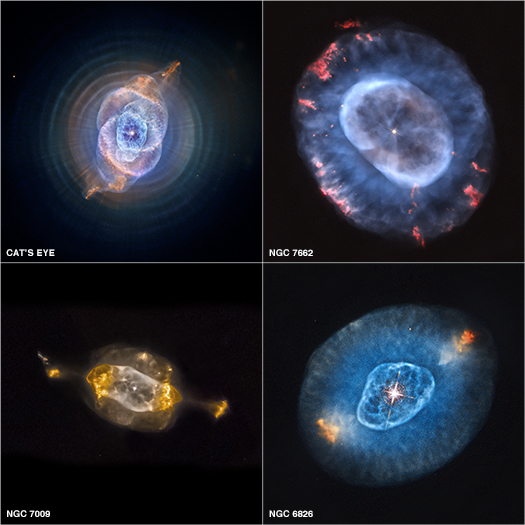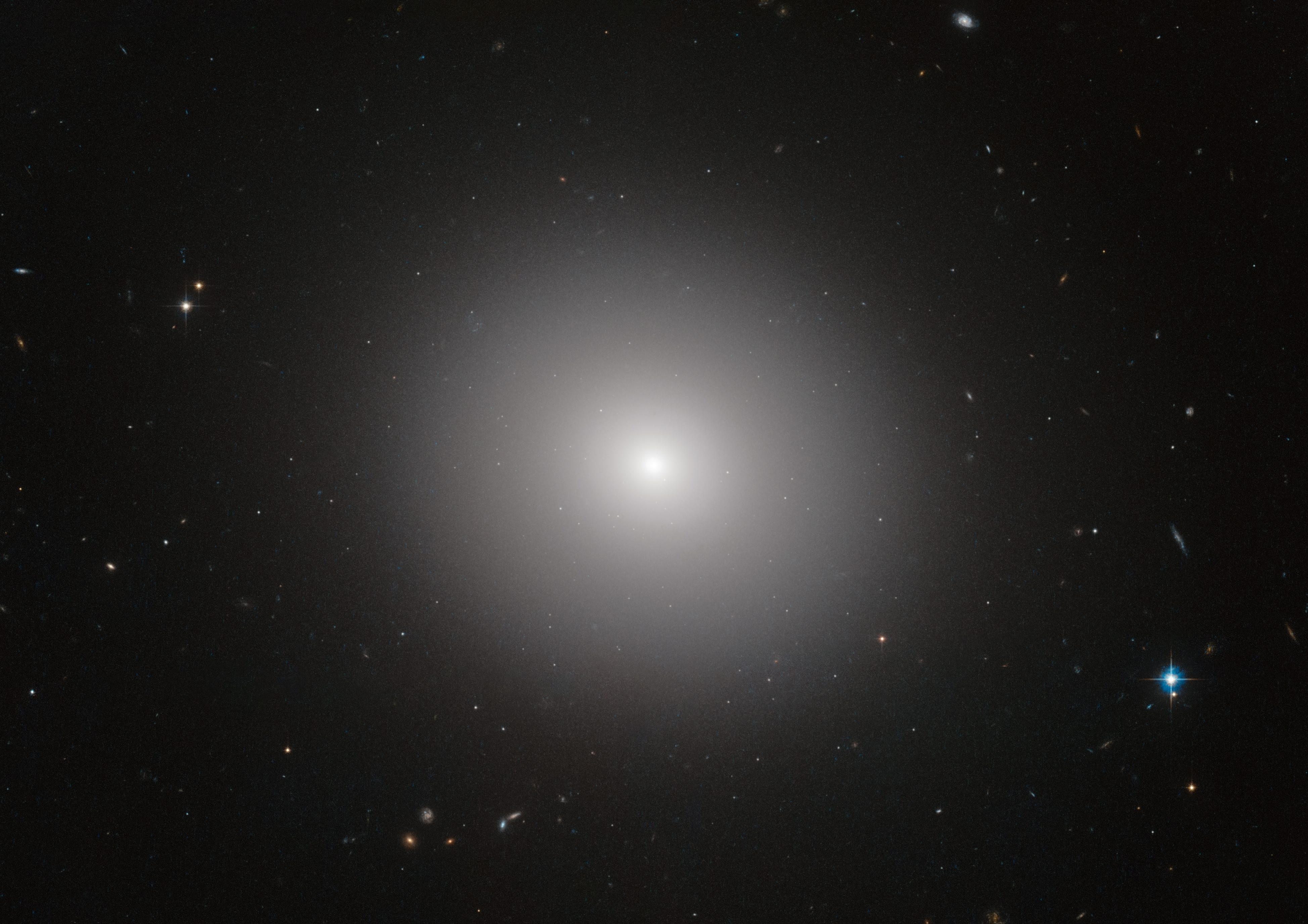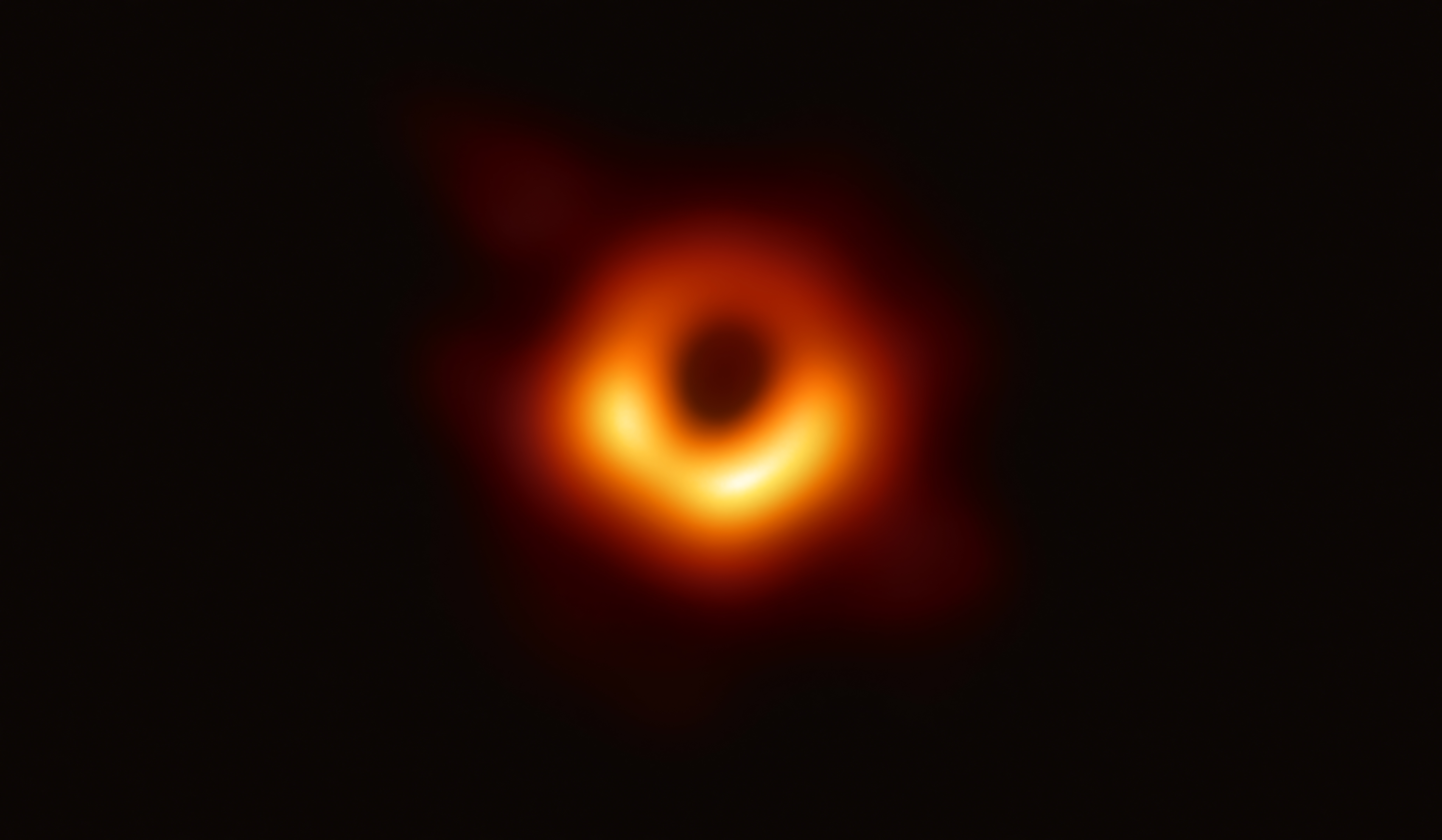|
NGC 4458
NGC 4458 is an elliptical galaxy located about 54 million light-years away in the constellation of Virgo. It was discovered by astronomer William Herschel on April 12, 1784. NGC 4458 is a member of Markarian's Chain which is part of the Virgo Cluster. It is in a pair with the galaxy NGC 4461. NGC 4458 and NGC 4461 are interacting with each other. NGC 4458 may have a supermassive black hole with an estimated mass of 200 million Suns ( M☉). Nuclear disk NGC 4458 has an edge-on nuclear disk which is estimated to be about 6 billion years old. The disk likely formed from the merger of a gas-rich galaxy and has been found to have "similar properties to the decoupled cores of bright ellipticals". L. Morelli, C. Halliday, E. M. Corsini, A. Pizzella, D. Thomas, R. P. Saglia, R. L. Davies, R. Bender, M. Birkinshaw, F. Bertola, Nuclear stellar discs in low-luminosity elliptical galaxies: NGC 4458 and 4478, Monthly Notices of the Royal Astronomical Society, Volume 354, Issue 3, Nov ... [...More Info...] [...Related Items...] OR: [Wikipedia] [Google] [Baidu] |
New General Catalogue
The ''New General Catalogue of Nebulae and Clusters of Stars'' (abbreviated NGC) is an astronomical catalog, astronomical catalogue of deep-sky objects compiled by John Louis Emil Dreyer in 1888. The NGC contains 7,840 objects, including galaxy, galaxies, star clusters and emission nebulae. Dreyer published two supplements to the NGC in 1895 and 1908, known as the ''Index Catalogues'' (abbreviated IC), describing a further 5,386 astronomical objects. Thousands of these objects are best known by their NGC or IC numbers, which remain in widespread use. The NGC expanded and consolidated the cataloguing work of William Herschel, William and Caroline Herschel, and John Herschel's ''General Catalogue of Nebulae and Clusters of Stars''. Objects south of the Celestial sphere, celestial equator are catalogued somewhat less thoroughly, but many were included based on observation by John Herschel or James Dunlop. The NGC contained multiple errors, but attempts to eliminate them were made by ... [...More Info...] [...Related Items...] OR: [Wikipedia] [Google] [Baidu] |
Markarian's Chain
Markarian's Chain is a stretch of galaxies that forms part of the Virgo Cluster. When viewed from Earth, the galaxies lie along a smoothly curved line. Charles Messier first discovered two of the galaxies, M84 and M86, in 1781. The other galaxies seen in the chain were discovered by William Herschel and are now known primarily by their catalog numbers in John Louis Emil Dreyer's New General Catalogue, published in 1888. It was ultimately named after the Soviet astrophysicist, Benjamin Markarian, who discovered their common motion in the early 1960s. Member galaxies include M84 (NGC 4374), M86 (NGC 4406), NGC 4477, NGC 4473, NGC 4461, NGC 4458, NGC 4438 and NGC 4435. It is located at RA 12h 27m and Dec +13° 10′. The bright members of the chain are visible through small telescope A small telescope is generally considered by professional astronomers to be any reflecting telescope with a primary mirror that is less than in diameter. By amateur standards, a small telescope ... [...More Info...] [...Related Items...] OR: [Wikipedia] [Google] [Baidu] |
Principal Galaxies Catalogue Objects
Principal may refer to: Title or rank * Principal (academia), the chief executive of a university ** Principal (education), the office holder/ or boss in any school * Principal (civil service) or principal officer, the senior management level in the UK Civil Service * Principal dancer, the top rank in ballet * Principal (music), the top rank in an orchestra Law * Principal (commercial law), the person who authorizes an agent ** Principal (architecture), licensed professional(s) with ownership of the firm * Principal (criminal law), the primary actor in a criminal offense * Principal (Catholic Church), an honorific used in the See of Lisbon Places * Principal, Cape Verde, a village * Principal, Ecuador, a parish Media * ''The Principal'' (TV series), a 2015 Australian drama series * ''The Principal'', a 1987 action film * Principal (music), the lead musician in a section of an orchestra * Principal photography, the first phase of movie production * "The Principal", a son ... [...More Info...] [...Related Items...] OR: [Wikipedia] [Google] [Baidu] |
NGC Objects
The ''New General Catalogue of Nebulae and Clusters of Stars'' (abbreviated NGC) is an astronomical catalogue of deep-sky objects compiled by John Louis Emil Dreyer in 1888. The NGC contains 7,840 objects, including galaxies, star clusters and emission nebulae. Dreyer published two supplements to the NGC in 1895 and 1908, known as the ''Index Catalogues'' (abbreviated IC), describing a further 5,386 astronomical objects. Thousands of these objects are best known by their NGC or IC numbers, which remain in widespread use. The NGC expanded and consolidated the cataloguing work of William and Caroline Herschel, and John Herschel's '' General Catalogue of Nebulae and Clusters of Stars''. Objects south of the celestial equator are catalogued somewhat less thoroughly, but many were included based on observation by John Herschel or James Dunlop. The NGC contained multiple errors, but attempts to eliminate them were made by the ''Revised New General Catalogue'' (RNGC) by Jack W. ... [...More Info...] [...Related Items...] OR: [Wikipedia] [Google] [Baidu] |
Elliptical Galaxies
An elliptical galaxy is a type of galaxy with an approximately ellipsoidal shape and a smooth, nearly featureless image. They are one of the four main classes of galaxy described by Edwin Hubble in his Hubble sequence and 1936 work ''The Realm of the Nebulae'', with their intermediate scale disks, a subset of the "early-type" galaxy population. Most elliptical galaxies are composed of older, low-mass stars, with a sparse interstellar medium and minimal star formation activity, and they tend to be surrounded by large numbers of globular clusters. Elliptical galaxies are believed to make up approximately 10–15% of galaxies in the Virgo Supercluster, and they are not the dominant type of galaxy in the universe overall. They are preferentially found close to the centers of galaxy clusters. Elliptical galaxies range in size from dwarf ellipticals with tens of millions of stars, to supergiants of over one hundred trillion stars that dominate their galaxy clusters. Originally, E ... [...More Info...] [...Related Items...] OR: [Wikipedia] [Google] [Baidu] |
Messier 86
Messier 86 (also known as M86 or NGC 4406) is an elliptical or lenticular galaxy in the constellation Virgo. It was discovered by Charles Messier in 1781. M86 lies in the heart of the Virgo Cluster of galaxies and forms a most conspicuous group with another large galaxy known as Messier 84. It displays the highest blue shift of all Messier objects, as it is, net of its other vectors of travel, approaching the Milky Way at 244 km/s. This is due to both galaxies falling roughly towards the center of the Virgo cluster from opposing ends. Messier 86 is linked by several filaments of ionized gas to the severely disrupted spiral galaxy NGC 4438, indicating that M86 may have stripped some gas and interstellar dust from the spiral. It is also suffering ram-pressure stripping as it moves at high speed through Virgo's intracluster medium, losing its interstellar medium and leaving behind a very long trail of X ray-emitting hot gas that has been detected with the help of the Ch ... [...More Info...] [...Related Items...] OR: [Wikipedia] [Google] [Baidu] |
List Of NGC Objects (4001–5000)
This is a list of NGC objects 4001–5000 from the New General Catalogue (NGC). The astronomical catalogue is composed mainly of star clusters, nebulae, and galaxies. Other objects in the catalogue can be found in the other subpages of the list of NGC objects. The constellation information in these tables is taken from ''The Complete New General Catalogue and Index Catalogue of Nebulae and Star Clusters by Jjiko. L. E. Dreyer'', which was accessed using the "VizieR Service". Galaxy types are identified using the ''NASA/IPAC Extragalactic Database''. The other data of these tables are from the SIMBAD Astronomical Database unless otherwise stated. 4001–4100 4101–4200 4201-4300 4301–4400 4401–4500 4501–4600 4601–4700 4701–4800 4801–4900 4901–5000 See also * Lists of astronomical objects This is a list of lists, grouped by type of astronomical object. Solar System * List of Solar System objects * List of gravitationally round ... [...More Info...] [...Related Items...] OR: [Wikipedia] [Google] [Baidu] |
Iron
Iron () is a chemical element with symbol Fe (from la, ferrum) and atomic number 26. It is a metal that belongs to the first transition series and group 8 of the periodic table. It is, by mass, the most common element on Earth, right in front of oxygen (32.1% and 30.1%, respectively), forming much of Earth's outer and inner core. It is the fourth most common element in the Earth's crust. In its metallic state, iron is rare in the Earth's crust, limited mainly to deposition by meteorites. Iron ores, by contrast, are among the most abundant in the Earth's crust, although extracting usable metal from them requires kilns or furnaces capable of reaching or higher, about higher than that required to smelt copper. Humans started to master that process in Eurasia during the 2nd millennium BCE and the use of iron tools and weapons began to displace copper alloys, in some regions, only around 1200 BCE. That event is considered the transition from the Bronze Age to the ... [...More Info...] [...Related Items...] OR: [Wikipedia] [Google] [Baidu] |
M☉
The solar mass () is a standard unit of mass in astronomy, equal to approximately . It is often used to indicate the masses of other stars, as well as stellar clusters, nebulae, galaxies and black holes. It is approximately equal to the mass of the Sun. This equates to about two nonillion (short scale), two quintillion (long scale) kilograms or 2000 quettagrams: The solar mass is about times the mass of Earth (), or times the mass of Jupiter (). History of measurement The value of the gravitational constant was first derived from measurements that were made by Henry Cavendish in 1798 with a torsion balance. The value he obtained differs by only 1% from the modern value, but was not as precise. The diurnal parallax of the Sun was accurately measured during the transits of Venus in 1761 and 1769, yielding a value of (9 arcseconds, compared to the present value of ). From the value of the diurnal parallax, one can determine the distance to the Sun from the geometry of ... [...More Info...] [...Related Items...] OR: [Wikipedia] [Google] [Baidu] |
Supermassive Black Hole
A supermassive black hole (SMBH or sometimes SBH) is the largest type of black hole, with its mass being on the order of hundreds of thousands, or millions to billions of times the mass of the Sun (). Black holes are a class of astronomical objects that have undergone gravitational collapse, leaving behind spheroidal regions of space from which nothing can escape, not even light. Observational evidence indicates that almost every large galaxy has a supermassive black hole at its center. For example, the Milky Way has a supermassive black hole in its Galactic Center, corresponding to the radio source Sagittarius A*. Accretion of interstellar gas onto supermassive black holes is the process responsible for powering active galactic nuclei (AGNs) and quasars. Two supermassive black holes have been directly imaged by the Event Horizon Telescope: the black hole in the giant elliptical galaxy Messier 87 and the black hole at the Milky Way’s center. Description Supermassive black ... [...More Info...] [...Related Items...] OR: [Wikipedia] [Google] [Baidu] |
NGC 4461
NGC 4461 (also known as NGC 4443) is a lenticular galaxy located about 50 million light-years away in the constellation of Virgo. It was discovered by astronomer William Herschel on April 12, 1784. NGC 4461 is a member of Markarian's Chain which is part of the Virgo Cluster. Interaction with NGC 4458 NGC 4461 is in a pair with the nearby galaxy NGC 4458. It has undergone a tidal interaction with NGC 4458. See also * List of NGC objects (4001–5000) This is a list of NGC objects 4001–5000 from the New General Catalogue (NGC). The astronomical catalogue is composed mainly of star clusters, nebulae, and galaxies. Other objects in the catalogue can be found in the other subpages of the list of ... * M86 References External links {{Virgo (constellation) Lenticular galaxies Virgo (constellation) 4461 Virgo Cluster 41111 7613 Astronomical objects discovered in 1784 ... [...More Info...] [...Related Items...] OR: [Wikipedia] [Google] [Baidu] |
William Herschel
Frederick William Herschel (; german: Friedrich Wilhelm Herschel; 15 November 1738 – 25 August 1822) was a German-born British astronomer and composer. He frequently collaborated with his younger sister and fellow astronomer Caroline Herschel (1750–1848). Born in the Electorate of Hanover, William Herschel followed his father into the military band of Hanover, before emigrating to Great Britain in 1757 at the age of nineteen. Herschel constructed his first large telescope in 1774, after which he spent nine years carrying out sky surveys to investigate double stars. Herschel published catalogues of nebulae in 1802 (2,500 objects) and in 1820 (5,000 objects). The resolving power of the Herschel telescopes revealed that many objects called nebulae in the Messier catalogue were actually clusters of stars. On 13 March 1781 while making observations he made note of a new object in the constellation of Gemini. This would, after several weeks of verification and consulta ... [...More Info...] [...Related Items...] OR: [Wikipedia] [Google] [Baidu] |



